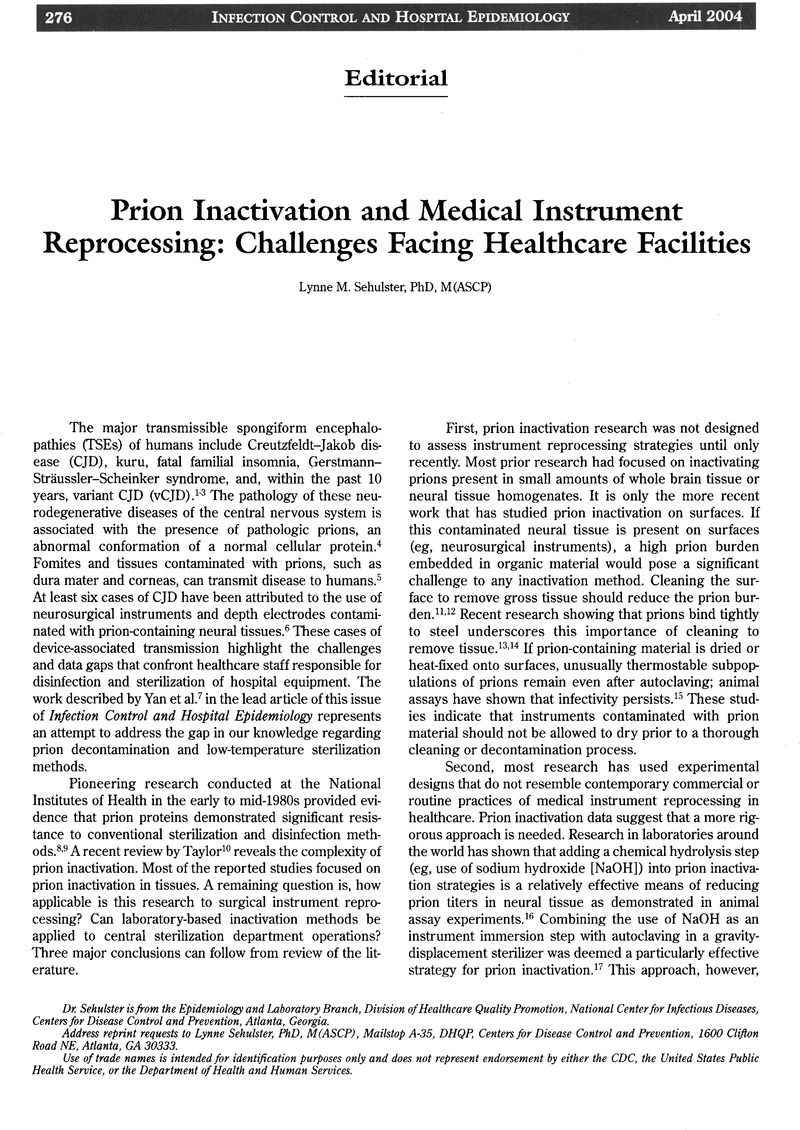Crossref Citations
This article has been cited by the following publications. This list is generated based on data provided by Crossref.
Lemmer, Karin
Mielke, Martin
Pauli, Georg
and
Beekes, Michael
2004.
Decontamination of surgical instruments from prion proteins: in vitro studies on the detachment, destabilization and degradation of PrPSc bound to steel surfaces.
Journal of General Virology
,
Vol. 85,
Issue. 12,
p.
3805.
Nelson, Douglas B
2006.
Current issues in endoscope reprocessing and infection control during gastrointestinal endoscopy.
World Journal of Gastroenterology,
Vol. 12,
Issue. 25,
p.
3953.
Lipscomb, I.P.
Pinchin, H.E.
Collin, R.
Harris, K.
and
Keevil, C.W.
2006.
Are surgical stainless steel wires used for intracranial implantation of PrPsc a good model of iatrogenic transmission from contaminated surgical stainless steel instruments after cleaning?.
Journal of Hospital Infection,
Vol. 64,
Issue. 4,
p.
339.
Sutton, J. M.
Dickinson, J.
Walker, J. T.
Raven, N. D. H.
and
Weinstein, R. A.
2006.
Methods to Minimize the Risks of Creutzfeldt-Jakob Disease Transmission by Surgical Procedures: Where to Set the Standard?.
Clinical Infectious Diseases,
Vol. 43,
Issue. 6,
p.
757.
Baxter, R.L.
Baxter, H.C.
Campbell, G.A.
Grant, K.
Jones, A.
Richardson, P.
and
Whittaker, G.
2006.
Quantitative analysis of residual protein contamination on reprocessed surgical instruments.
Journal of Hospital Infection,
Vol. 63,
Issue. 4,
p.
439.
Asher, David M.
2008.
Principles and Practice of Pediatric Infectious Disease.
p.
339.
Walker, J.T.
Dickinson, J.
Sutton, J.M.
Marsh, P.D.
and
Raven, N.D.H.
2008.
Implications for Creutzfeldt-Jakob Disease (CJD) in Dentistry: a Review of Current Knowledge.
Journal of Dental Research,
Vol. 87,
Issue. 6,
p.
511.
Smith, Gordon W.G.
and
Smith, Andrew J.
2012.
Evaluation of residual protein on unprocessed and decontaminated dental extraction forceps.
Biofouling,
Vol. 28,
Issue. 9,
p.
921.
Sehulster, L.M.
2012.
Sterilisation of Biomaterials and Medical Devices.
p.
261.
Thomas, Jonathan G.
Chenoweth, Carol E.
and
Sullivan, Stephen E.
2013.
Iatrogenic Creutzfeldt-Jakob disease via surgical instruments.
Journal of Clinical Neuroscience,
Vol. 20,
Issue. 9,
p.
1207.
Wilhelm, Nadja
Perle, Nadja
Simmoteit, Robert
Schlensak, Christian
Wendel, Hans P.
and
Avci-Adali, Meltem
2014.
Use of Synthetic Single-Stranded Oligonucleotides as Artificial Test Soiling for Validation of Surgical Instrument Cleaning Processes.
BioMed Research International,
Vol. 2014,
Issue. ,
p.
1.
Eraña, Hasier
Pérez-Castro, Miguel Ángel
García-Martínez, Sandra
Charco, Jorge M.
López-Moreno, Rafael
Díaz-Dominguez, Carlos M.
Barrio, Tomás
González-Miranda, Ezequiel
and
Castilla, Joaquín
2020.
A Novel, Reliable and Highly Versatile Method to Evaluate Different Prion Decontamination Procedures.
Frontiers in Bioengineering and Biotechnology,
Vol. 8,
Issue. ,
England, Tracey
Behrens, Doris A.
Davies, Thomas
and
Gartner, Daniel
2024.
Impact of Digital Solutions for Improved Healthcare Delivery.
p.
147.



